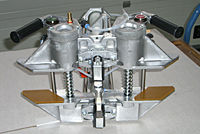
Contact Details:
GGB (formerly Garlock Bearings)
Wellington House
Starley Way
Birmingham International Park
Birmingham
Birmingham
B37 7HB
United Kingdom
Tel: +44 (0)121 7679100
Fax: +44 (0)121 7817313
Send Enquiry | Company Information

Metal-polymer bearings keep weld cutoff machines on track
Product News Thursday, January 27, 2011: GGB (formerly Garlock Bearings)
The production of vinyl windows involves removing the weld beads from the inside corners of the leaf and frame profiles. Heinz Zierke Kunstoffenster – Bearbeitungsmaschinen, Heimertigen, Germany, has been manufacturing milling machines for this purpose for more than 35 years.
The company offers radius milling machines; universal cut-off machines that can also be used for non-standard window angles; hand-grooving machines for double-sided weld removal; and weld cut-off machines for two-sided operation.
The slide mountings and rail guides of its manually operated machines now incorporate unlubricated, metal polymer bearings from GGB (formerly Glacier Garlock Bearings) to reduce friction, improve operator comfort by reducing stiction effect and prolong the life of the rail guides without the expense of replacing the entire bearing/housing system. Previously the company had not used any type of bearings in this application.
The sliding layer of each of the four DU® bearings per machine is counter-bored for limited clearance, while maintaining more than adequate service life. Guides without bearings are used in some applications where tolerances are not critical.
The self-lubricating bearings provide excellent friction performance in rotating, sliding or oscillating motion applications. Unlubricated they can withstand loads of up to 3.5 MPa x m/s, speeds up to 2.5 m/s and temperatures ranging from -200°C to +280°C, but they also perform well with lubrication. The structure of the bearings consists of a rigid steel backing, which provides exceptionally high load-carrying capacity, while a porous bronze inner layer impregnated with a homogeneous mixture of PTFE and lead provides maximum thermal conductivity.
